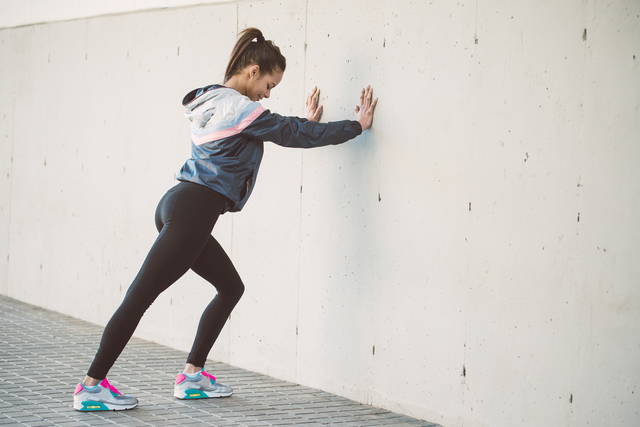Do stretches help shin splints?
Yes, most soft tissue injuries – shin splints included – result from excessive strain on the related muscles. Splints can arise when the key muscles that control the lowering of your foot at each step and maintain the longitudinal foot arch are put under too much strain too quickly. The main muscle groups in question are the tibialis anterior and the tibialis posterior.
The best way to avoid this injury is with a graduated training programme tailored to your current fitness and strength undertaken alongside regular and quality stretching sessions.
How does stretching help?
Stretching is an unquestionably important element to alleviating the symptoms of shin splints as well as avoiding stress fractures. Without gradual training and building up of muscles, as you increase their activity and mileage, these muscles start to break down. Injury results because the muscles are too weak and too short to do the job that they’re being asked to do. Exercises help to strengthen the muscles and stretches help to lengthen them (increase flexibility).
Need more of an incentive to stretch?
- shin splints are a muscle injury, and the pain fades once the muscle is warmed up.
- fractures are a bone injury, and the pain worsens as you run.
As such, shin splints can be alleviated through a careful rehab and stretching plan, alongside gentle, low-impact exercise. Stress fractures on the other hand, need rest to allow the body time to heal the bone.
Best stretches for shin splints: tibialis anterior
Toe drag stretch
- With both knees bent slightly, place the foot of the affected leg just behind your other leg with the toes touching the ground.
- Keeping your toes firmly on the ground, pull this leg forward, pressing slightly on your toes until you feel a stretch from the top of this foot, though to your shins.
- Hold for 30 seconds then switch legs.
Tip: do this on a mat with bare feet or socks and don’t physically drag the foot forward.
Kneeling shin stretch
- Kneel on a mat with the tops of your feet flat on the floor and your buttocks over your heels.
- Hold for 30 seconds or more.
Tip: if and when this feels comfortable, you can extend the stretch by leaning your body backwards slightly.
Seated shin stretch
- Drop one knee towards the ground so that the top of your foot is facing the floor and your toes are touching the ground (as in the toe drag stretch).
- Gently pull this leg forward so that the foot stays still but you can feel a stretch from the top of this foot, though to your shins.
- Hold for 20 seconds then switch legs.
Tip: this works best when you can maneuver your leg under and behind you while seated, so choose a chair accordingly!
Lying shin stretch
- Lie on your side, with the leg closest to the ground bent behind you at the knee.
- Reach back and hold this foot, then pull it gently towards your back.
- Hold for 20 seconds and switch sides and legs.
Tip: this stretch is similar to the lying quadriceps stretch.
Best stretches for shin splints: tibialis posterior
Ankle flex
- Lie on your back with both legs bent.
- Lift one leg off the floor, so that the sole of your foot points towards the sky.
- Hold your leg with both hands, slightly below the knee.
- Slowly point and flex your toes approximately six times.
- Perform ankle rotations in both clockwise and anti-clockwise direction.
- Repeat on the other leg
Tip: the stretching leg doesn’t need to be completely straight. Hold it up as straight as you can without pain or shaking but always maintain a slight bend at the knee.
Calf stretch
- Stand facing a wall with all toes pointing towards the wall.
- Take a step forward with one leg, with your feet parallel to one another.
- Push your hands against the wall and bend the front leg, keeping your back leg as straight as possible.
- Hold for 30 seconds then switch legs.
Tip: to extend the stretch, place the front foot so that it is in line with the other foot (as opposed to parallel). Toe crunches
- Curl up your toes as if you were going to pick something off the floor with them.
Tip: you can actually pick up marbles or similarly sized items if the action helps you to perform the stretch correctly.
If you’re suffering from, or are prone to developing, shin splints, wear Enertor Walking insoles.Their innovative PX1 shock absorption material, means that they can protect your shins by absorbing the shock that your muscles aren’t.
For more information on the prevention and treatment of shin splints, visit our injury advice page.

